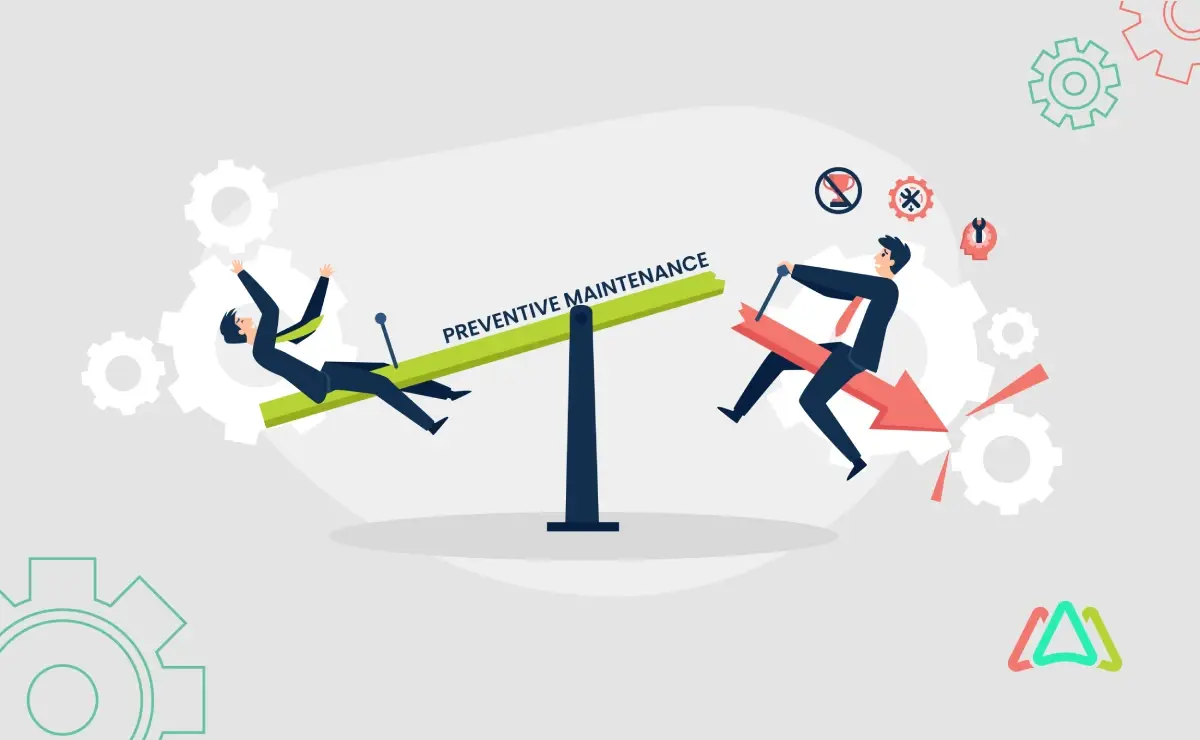
The Preventive Maintenance Paradox: Why Some Companies Do Not See the Results?
A substantial amount of literature exists discussing the topic of preventive maintenance. Various sources, including books, blogs, websites, videos, and podcasts, emphasize the necessity and importance of preventive maintenance in successful maintenance management strategies. Without effective preventive maintenance, maintenance operations suffer, leading to increased costs, downtime, loss of productivity, and missed market opportunities – all of which can negatively impact a business.
Preventive maintenance has received significant endorsement not only in terms of literature but also from companies that have adopted it. One would expect businesses to prioritize making their preventive maintenance programs successful. However, this is not always the case. In his book on preventive maintenance, Terry Wireman references a survey conducted on approximately 5,000 companies over a 40-year period (1965 to 2004). The results revealed that the majority were unsatisfied with their preventive maintenance program's effectiveness. A paradox, indeed. What explains this contradiction? Why does preventive maintenance as an effective maintenance strategy end up receiving poor traction and adoption? Is it like doing regular exercise, perhaps? We all understand that exercise is beneficial for our health, but only a few do it regularly.
A Comprehensive Survey on Preventive Maintenance
Terry Wireman, famous for his research and expertise on maintenance management best practices, explores this paradox well in his published series, “Maintenance Strategy.” In Volume I of the Maintenance Strategy series, titled ‘Preventive Maintenance,’ Wireman references a survey to measure the effectiveness of preventive maintenance programs in 5,000 companies.
Effectiveness is measured by the ability to plan and schedule at least 80% of maintenance activities one week in advance. This benchmark indicates that an organization is transitioning from a reactive culture to a more proactive one.
The first survey covering 5,000 companies was done in 1965. (Figure 1.1)
1965 Survey (Figure 1.1)

Source: Preventive Maintenance, Maintenance Strategy Series, Volume I (5,000 companies survey)
2004 Survey (Figure 1.2)

Source: Preventive Maintenance, Maintenance Strategy Series, Volume I (5,000 companies survey)
Another survey in 2004 (Figure 1.2) produced similar results. Interestingly, the percentage of respondents who deemed their preventive maintenance program ineffective remained nearly constant between the two surveys conducted 40 years apart (1965 and 2004). This raises the question: Why has there been no significant progress in improving the effectiveness of company maintenance programs?
Wireman’s research presents the following three reasons that contribute to this lack of progress.
1. Preventive Maintenance Activities Don’t Get Recognition
Preventive maintenance activities are often overlooked due to their low profile and visibility. To transition from a reactive to a proactive preventive maintenance approach, companies must first overcome this obstacle. In a reactive culture, the "hero technician" who can quickly fix problems is highly valued, leading technicians to believe that preventive maintenance activities are not as important. This issue can only be resolved when upper and mid-level managers demonstrate their appreciation for preventive maintenance activities over the "fix it fast" and “save the day” reactive approach. Without management’s support, technicians will continue to recognize and associate high value to reactive maintenance activities like troubleshooting and fixing it when it breaks. Management needs to communicate the cost savings and impact on the organization and maintenance personnel’s jobs that come with preventive maintenance in order to get buy-in from the team. Communication needs to be ongoing to change the culture and mindset of the maintenance team.
2. Lack and Shortage of Maintenance Skills
Another challenge is the lack of basic maintenance skills among technicians in many companies in the study. They often cannot identify developing problems with equipment components, perform basic lubrication tasks, or make proper adjustments to their assigned equipment. Consequently, even when an organization's structure and culture are conducive to change, these skill deficiencies still hinder the success of a preventive maintenance program.
3. Lack of Discipline in Implementing a Preventive Maintenance Program
The third obstacle is the absence of a disciplined development process for preventive maintenance. It is easy for companies to pay lip service to preventive maintenance or claim that it is ineffective in their industry. However, examples of successful preventive maintenance strategies can be found in every industry.
For instance, Engineered Systems Magazine featured an article on maintaining proper humidity levels in facilities—a typical preventive maintenance function—emphasizing that not maintaining humidity levels properly through preventive maintenance can cost companies thousands, even millions of dollars.
An auto supplier in the US successfully implemented a preventive maintenance program to reduce equipment breakdowns and improve productivity. The PM program helped the company reduce conveyor system incidences by 48%, equipment downtime by 24%, and clear out its overdue work order backlog.
The impact of an effective preventive maintenance program on a company's bottom line is significant. In a Business Week article, it was noted that an electronics manufacturer developed a fixed pattern for preventive maintenance tasks and reinforced them through constant repetition. As a result, electrical breakdowns have been reduced by 80% since 1990, leading to millions of dollars in savings. These examples demonstrate how preventive maintenance can contribute to a company's profitability.
Does the Preventive Maintenance Paradox Still Exist Today?
The year is 2024, and the world has become increasingly modern and digital. Software is now an integral part of daily life, as predicted by Marc Andreessen, who once said that software would eat the world. Indeed, since 2004, the world has been transformed by software. In this software-driven era, one may question whether preventive maintenance programs have found acceptance and effectiveness. While it appears that they have, to some extent, room for improvement.
Preventive maintenance software and Computerized Maintenance Management Systems (CMMS) have become mainstream, with businesses of all sizes adopting strategic digital projects that enable preventive maintenance programs. The global pandemic in 2020 further accelerated this trend. Additionally, the United States is on the verge of a manufacturing renaissance, creating an environment conducive to effective preventive maintenance plans aimed at enhancing business effectiveness.
However, despite these positive developments, the 2024 survey conducted by Limble CMMS revealed some intriguing findings. The survey, titled "The State of Maintenance in Manufacturing and Facilities," examined the main challenges faced by 252 manufacturing and facility maintenance professionals. Although the survey did not directly measure the effectiveness of preventive maintenance programs, two questions within the study yielded noteworthy results.
One question asked participants about their top challenges. Interestingly, downtime and breakdowns emerged as a primary concern, along with skill shortages and aging infrastructure. A significant number of maintenance professionals are utilizing preventive maintenance strategies to address downtime issues. In terms of challenges, 51% were affected by downtime and breakdowns, while 78% relied on preventive maintenance to solve these problems.
It is interesting to note that, despite the reliance on preventive maintenance to address breakdowns, it appears not to be effectively addressing the challenge. This may indicate a need for further consideration behind the numbers. The primary point being emphasized is that the problem or paradox of preventive maintenance programs may still persist and has not been entirely resolved. On the flip side, there is no doubt that adopting a preventive maintenance program and using software like a CMMS to manage it is a step in the right direction. It can reduce costs, improve productivity, and avoid costly breakdowns and interruptions in production.
To learn more, check out our article on the Top 5 Benefits of Preventive Maintenance Software.
TABLE OF CONTENTS
Keep Reading
Every maintenance professional faces it sooner or later — that critical time when an aging ...
18 Nov 2025
The term 'best' is often used loosely, without a clear understanding of its context or ...
14 Nov 2025
In the not too distant past, maintenance strategies have been defined by reaction—fixing ...
13 Nov 2025
Tax season is the time of year that often sends a ripple of anxiety through many of us. The ...
11 Nov 2025
Selecting a Computerized Maintenance Management System (CMMS) can, at first glance, be an ...
4 Nov 2025
In healthcare facilities, equipment uptime involves more than achieving operational ...
31 Oct 2025
Companies are subject to economic ups and downs, also known as economic volatility. Today, ...
30 Oct 2025
Maintenance challenges are a constant struggle, with unplanned downtime costing manufacturers ...
27 Oct 2025
Last winter, a maintenance technician at a U.S. paper mill ignored a predictive alert that ...
10 Oct 2025
Many organizations proudly say they “have a CMMS,” but ownership alone doesn’t equal ...
9 Oct 2025
Every maintenance team is under pressure to do more with less. Unplanned downtime is often ...
7 Oct 2025
The implementation of simple, yet powerfully effective, checklists has repeatedly ...
3 Oct 2025
In manufacturing, every second counts. When production stops, whether due to scheduled ...
2 Oct 2025
The increasing cost of maintenance, lack of accountability, and siloed systems leave many ...
30 Sep 2025
Preventive maintenance is one of those things maintenance teams know they need to do, but it ...
26 Sep 2025
Public services are essential to daily life. The provision of safe roads, functional transit, ...
25 Sep 2025
For most manufacturing facilities, a major focus of their maintenance teams revolves around ...
24 Sep 2025
Have you ever tried explaining to the CEO why the production line has been down for hours ...
18 Sep 2025
Over the past few decades, the hotel industry has undergone a dramatic transformation. ...
16 Sep 2025
Profitability is at the top of the list for manufacturing organizations when conversations ...
12 Sep 2025





